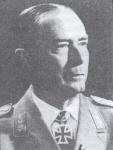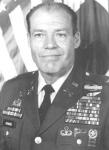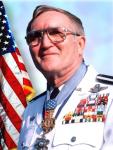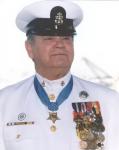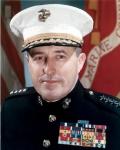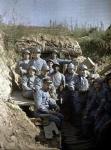-
Posts
4,908 -
Joined
-
Last visited
-
Days Won
97
Content Type
Profiles
Forums
Blogs
Gallery
Events
Store
Everything posted by Dave Danner
-
One more: GenLt. Gerhard Matzky. Born on 19 March 1894, he entered service with 4. Oberschlesisches Inf.-Regt. Nr. 63 before World War I (his patent is dated 1911, but was likely backdated). He served in Upper Silesia in the Freikorps after the war (so he should have the Silesian Eagle, but I don't see it on his awards list). He was Military Attache in Tokyo when the war began, and commanded 21. Infanterie-Division in 1943-44, and then XXVIII and XXVI Armeekorps until war's end. In 1951, he became Inspector of the Bundesgrenzschutz. In the Bundeswehr, he commanded I (German) Corps. Decorations include: Knight's Cross German Cross in Gold 1914 EK1 with 1939 clasp 1914 EK2 with 1939 clasp- EK I: 00.08.1915 Hamburg Hanseatic Cross Saxe-Meiningen Cross for Merit in War Wound Badge in Silver War Merit Cross I. and II. Class with Swords Finnish Cross of Liberty I. Class with Swords Gro?es Bundesverdienstkreuz
-
GenMaj. Richard Schimpf. Born 16 May 1897, died 30 December 1972. Entered service as a Fahnenjunker with 9. bayerisches Infanterie-Regiment Wrede. He transferred to the Luftwaffe in 1935 and held various command and staff positions until taking command of Luftwaffe-Division Meindl in September 1942 and 21.Luftwaffe-Feld-Division in November. He took command of 3. Fallschirm-Division shortly before the Normandy invasion and was severely wounded fighting the Allies in France in August 1944. He returned to command his division in January 1945, leading it until the end of the war. He reentered the Luftwaffe in 1957, commanding Wehrbereichskommando III (D?sseldorf) until 1962. Decorations include: Knight's Cross German Cross in Gold 1914 EK1 with 1939 clasp 1914 EK2 with 1939 clasp Bavarian Military Merit Order 4th Class with Swords Wound Badge in Black Medaille "Winterschlacht im Osten 1941/1942" Hungarian Pilot's Badge Gro?es Bundesverdienstkreuz.
-
Not sure about either Wolf-Dietrich Freiherr von Schleinitz or Gottfried Weber. As for Friedrich Stammbach, there was a Lt. Stammbach with Eisenbahn-Regiment Nr. 2 in WW1, who is listed in the Ehrenrangliste as continuing as a Leutnant in the Reichswehr, with the 1. Pionier-Bataillon. This would be consistent with GenMaj. Stammbach's service in World War Two as head of the Pionier und Eisenbahn-Pionierabteilung (Wa Pruf 5) in the Heereswaffenamt. Some biographical detail on Curt Siewert can be found here: http://www.specialcamp11.fsnet.co.uk/Gener...t%20Siewert.htm His Bundeswehr service, not listed at that site, was as Commanding General, I Corps (mdFb) from 1956-1957, Deputy Commanding General, III Corps in 1957 and Commander, Wehrbereichskommando II (Hannover) from 1958 to 1960. Here are bios on Hans-Joachim von Horn and Kurt Freiherr von Liebenstein: http://www.geocities.com/~orion47/WEHRMACH.../HORN_HANS.html http://www.geocities.com/~orion47/WEHRMACH...STEIN_KURT.html
-
Joseph von Radowitz was a veteran of World War One, as the only WW2 picture I've seen of him shows a ribbon bar with the 1914 EK2 with 1939 clasp, FKE and two Wehrmacht-Dienstauszeichnungen. The Ehrenrangliste shows only one Lt. von Radowitz, with 1. Badisches Leib-Dragoner-Regiment Nr. 20, but I would guess that this is likely not Joseph. If it were Joseph, it is rather odd that he wouldn't have at least a Baden Silver Merit Medal. Also, if born in 1899, by 1918 he would likely have still been an officer candidate. In World War Two, he added an EK1, a German Cross on Gold and a Knight's Cross with Oakleaves (882nd), and commanded 23.Panzerdivision. In the Bundeswehr, he was "Ltr Annahmestelle" which I believe would be a reception station for draftees/basic trainees.
-
I can't find any good Bundeswehr pictures of most of these. Here is more on the rather interesting Paul Reinhold Herrmann. Born in 1898, he entered the army on July 1, 1916 as a Fahnenjunker in IR32. He was promoted to Leutnant on October 5, 1917. He spent most of the war with IR32, but was assigned to RIR32 shortly before the Armistice. Working his way up the ranks, he was primarily a staff officer in WW2, including as 1a of Army Group North during the invasion of the USSR. In 1945, he was given command of 264.Infanterie-Division. After the war, he served as a military expert for the defense at the Nuremberg Tribunal and then was in private business. In 1956, he entered the Bundeswehr and commanded Wehrbereichskommando IV (Mainz) until retiring in 1961. His WW1 decorations include the EK1, EK2, Saxe-Meiningen Cross for Merit in War, Wound Badge in Black and Honor Cross for Combatants. His WW2 decorations include the German Cross in Gold, the 1939 clasps to his EK1 and EK2, and the Medaille "Winterschlacht im Osten 1941/1942". This is what makes him interesting: he has what may be a unique distinction. He appears to be the only military officer (maybe the only person, period) with both the West German Gro?es Bundesverdienstkreuz and the Blood Order of the NSDAP. Somehow I don't think the latter made it onto his post-1957 ribbon bar.
-
Also not strictly an Imperial "officer": Heinrich-Georg Hax. He entered service as a Kriegsfreiwillige (war volunteer) on January 26, 1918, two days after his 18th birthday. He became a Fahnenjunker in IR64 in August 1918. He spent most of 1919 in Freikorps service, entering the Reichswehr in October of that year. He made Leutnant in 1922 and worked his way up to Generalmajor on April 1, 1945. He entered the Bundeswehr as a Brigadegeneral on Sept. 3, 1956 and was promoted to Generalmajor on Sept. 12, 1957. He spent most of WW2 in staff positions, and in 1944 became commander of Panzer-Grenadier-Regiment 110 (or 111). In 1945 he took command of 8. Panzerdivision. Although captured by the Americans, he was transferred to Soviet custody and was a Soviet POW until 1955. In the Bundeswehr, he commanded 3. Panzerdivision. In 1958 he became deputy commanding general of III (German) Corps, retiring in 1961 and dying in 1963. His only WW1 decoration was the Honor Cross for Combatants. Other decorations and honors include the Gro?es Bundesverdienstkreuz, Knight's Cross with Oakleaves (855th oakleaves), EK1 and EK2. In the 1928 Olympics in Amsterdam, he came in 5th in the Modern Pentathlon. He took the Silver Medal in Shooting (25m Rapid Fire Pistol) in both the 1932 Los Angeles and 1936 Berlin Games.
-
One more: Smilo Freiherr von L?ttwitz. He entered service in August 1914 with Leib-Dragonerregiment (2. Gro?herzoglich Hessisches) Nr. 24. He was wounded three times in 1915 while fighting on the Russian Front. After his brother was KIA, his father arranged to have him transferred to be an Ordonnanzoffizier on a corps staff and on the staff of Army Group Crown Prince (Heeresgruppe Kronprinz), where he served for two years until becoming regimental adjutant of the Hessian Life Dragoons in 1918. His father later was one of the leaders of the Kapp-Putsch. His bio on the Ritterkreuztr?ger web site doesn't list all awards, but notes that "bei Kriegsende besa? er au?er dem silbernen Verwundetenabzeichen und beiden Eisernen Kreuzen (I. und II. Klasse) noch drei weitere deutsche und ?sterreichische Orden." I would assume one of the German ones was the Hessen General Honor Decoration for Bravery and the Austrian one was likely the Military Merit Cross with Swords and War Decoration. No idea about the third. The only WW2 pictures I've seen of him don't show a ribbon bar and the only Bundeswehr picture I've seen is too small and grainy to make out the ribbons. In WW2, he added the 1939 clasps to the EK1 and EK2, the German Cross in Gold, the RK, Oakleaves (426th) and Swords (76th). He reached the rank of General der Panzertruppen and commanded, among others, a Panzerdivision, a Panzerkorps, an army corps, and 9. Armee. In 1957, he returned to service as a Generalleutnant and commander of III (German) Corps. He served until 1960, receiving the Gro?es Bundesverdienstkreuz and the US Legion of Merit. A bio is here: http://www.ritterkreuztraeger-1939-45.de/I...reiherr-von.htm
-
One nit: while the literal translation from German would be Freedom Medal 1st Class, the 1. luokan Vapaudenmitali is more commonly referred to as the Medal of Liberty 1st Class, as the Vapaudenristi is usually called the Cross of Liberty. English is enriched by being able to draw on Latin and Germanic vocabularies and having two or more words for the same concept (e.g., preface/foreword), but sometimes it can give you too much versatility. Of course, the other medal for which you have the document, the Vapaussodan muistomitali, is usually translated into English as War of Independence Commemorative Medal, but the German translation as Erinnerungsmedaille des Freiheitskrieges is actually more accurate. "Independence" is riippumattomuus. It is a nice group of documents. It may be incomplete, as you note, but it certainly captures what are likely the high points of this guy's career.
-
First says at the top "Together with our company tailor", followed by "1 May 1941, your brother Robert". Below that is "Photographed by _______ Herbert Klein, Frankenroda in Eisenach." Second also says at the top "Together with our company tailor", followed by a name which looks like Rudolf Kummell. Below that is "My little ____ ______ in war year 1942, Robert." Last says "Roberts Geburtstagsfeier", or Robert's birthday party.
-
A friend of mine found one of these once for $5 in a box of costume jewelry in an antique mall in Lake Worth, Florida. Because of the design, they had no idea it was a military award.
-

Sometimes a huge rack of fruit salad means something
Dave Danner replied to Dave Danner's topic in United States of America
In Col. Howard's case, note that he is wearing his NCO Professional Development Ribbon, Army Service Ribbon and Army Overseas Service Ribbon. I suppose he could have dispensed with them and no one would complain, but who's going to tell him different? -

Sometimes a huge rack of fruit salad means something
Dave Danner replied to Dave Danner's topic in United States of America
-

Sometimes a huge rack of fruit salad means something
Dave Danner replied to Dave Danner's topic in United States of America
-

Sometimes a huge rack of fruit salad means something
Dave Danner replied to Dave Danner's topic in United States of America
-
Photography and film are not the same. Color photography was developed in France before World War I. The Autochrome Lumi?re process was patented by the Lumi?re brothers in 1907. The photos Ulsterman shows above were done by that process. Agfa developed Agfacolor, a better process, in Germany in the mid-1930s; Kodachrome arrived about the same time, but was not as easy to use, so color photography was more widely seen among Germans in World War II. There was no color film in World War I. The film footage referred to in Sal's original post was, as Christophe notes, colorized.
-

One Act -- Two Medals of Honor
Dave Danner replied to Chuck In Oregon's topic in United States of America
One thing to bear in mind on the "double dipping" issue: As noted above, date of action and date of award aren't the same and can be separated by periods of up to years. Army MOH citations from the period usually include the number of the War Department General Order authorizing the award. Most Navy citations don't have a corresponding Navy Department order, so we don't always know when the award was made. So in many cases it may not be that the Marine received two medals from two services for the same action, but that the Army awarded the Medal to a Marine serving under Army command, and the Navy later approved its own award. The Navy would not have had the authority to rescind the Army's award, so both stay. It is with the Navy Cross where this becomes readily apparent. The Army DSC and DSM were authorized in early 1918, and were available for award in World War One. The Navy Cross and Navy DSM were not authorized until February 1919, after the war had ended. So for the most part, the 326 Marines and 17 sailors who received both the Navy Cross and Army DSC for the same action likely received the Army medal first, and were subsequently authorized the Navy's version, without rescinding the earlier award. So the Navy seems to have had a postwar policy to correct the problem associated with not having had its own awards. The question then becomes not "why did these Marines and sailors receive both awards?", but why one Marine received only the Army Medal of Honor, and why, of the 43 Navy and 357 Marine recipients of the DSC, the Navy did not subsquently decorate 25 of these sailors and 31 of these Marines. -

One Act -- Two Medals of Honor
Dave Danner replied to Chuck In Oregon's topic in United States of America
Vera Cruz is actually pretty notorious for the number of MOHs awarded by the Navy. The Army awarded one. Nine Marines received the Navy Medal of Honor. The Navy awarded 46 to sailors and Navy officers, and the citations are often extremely vague. None were posthumous. The rank breakdown is also a little skewed. The Army Medal and all 9 Marine awards went to officers. Thirty of the 46 Navy awards went to Navy officers - 1 Rear Admiral, 3 Captains, 3 Commanders, 2 Lt. Commanders, 11 Lieutenants, 2 Lieutenants j.g., 6 Ensigns and 2 Surgeons. The 46 Navy recipients in Vera Cruz compares to 21 in World War One and 57 in World War Two. To be fair, though, there were a lot of ships, plus a provisional Naval Brigade of disembarked bluejackets, at Vera Cruz. Almost every battleship in the Navy at the time was involved in the operation in some way. But the number of medals was rather disproportionate to the actual amount of fighting. There were 17 KIAs (4 Marines and 13 bluejackets) and two bluejackets died of wounds. 14 Marines, 64 bluejackets and one Navy officer were wounded. -

One Act -- Two Medals of Honor
Dave Danner replied to Chuck In Oregon's topic in United States of America
Navy Medals of Honor for World War One present a more complicated picture. At the time, Army and Navy award criteria differed. The Army Medal of Honor could only be awarded for valor in the face of the enemy. The Navy Medal, by contrast, could be awarded for noncombatant valor, often lifesaving under extreme circumstances. Twenty-eight Navy Medals of Honor were awarded in World War One. Twenty-one went to sailors and seven to Marines. Marines As previously noted, five Marine recipients also received the Army Medal and a sixth, Gunny Stockham, received only the Army Medal. The other two Marine recipients were aviators - Gy/Sgt. Robert G. Robinson and 2nd Lt. Ralph Talbot, both with the 1st Marine Aviation Force. Both of theirs were for the same actions. Corpsmen The Marine Corps does not have its own medical personnel; instead, Navy doctors and corpsmen are assigned to Marine units. Six of the 21 Navy recipients were doctors and corpsmen on the Western Front - two corpsmen: Pharmacist's Mate 1st Class John H. Balch and Hospital Apprentice 1st Class David E. Hayden; two dentists: Lt. Cdr. (DC) Alexander G. Lyle and Lt. (j.g.) (DC) Weedon E. Osborne; and two doctors: Lt. (MC) Joel T. Boone and Lt. (MC) Orlando H. Petty. As noted above, Lt. Petty also received the Army DSC. Non-combat awards Of the 21 awards to sailors, 10 were for acts of heroism not involving enemy action. Without denigrating the bravery involved in each case, it should be noted that Navy regulations later changed to conform to Army regulations, and such acts would not result in a Medal of Honor today. The Navy and Marine Corps Medal is the primary award for non-combat heroism. In addition to these 10, several Navy awards did involve engagements with the enemy, but the actual act was more like those of the non-combatant awards. In one case, an ensign acted to secure depth charges knocked loose by a nearby explosion of a depth charge the ship had dropped on a U-boat, saving the ship from an explosion. In another, a Gunner's Mate sacrificed his life trying to release depth charges before a torpedo struck his ship, trying to avoid the resulting secondary explosions. In the Navy, of course, self-sacrifice to save your ship is often more important than saving a life or attacking the enemy, since many lives are at risk if the ship goes down. Another incident indirectly involving enemy action was where an ensign risked his seaplane to land and pick up the pilot of a downed seaplane, while under threat from Austro-Hungarian aircraft. Combat at sea Only one Navy Medal of Honor went to a sailor for heroism in combat at sea. This was to Lt. Cdr. James J. Madison, commanding officer of the U.S.S. Ticonderoga, a German steamer seized by the US at the beginning of the war and outfitted as a transport. It was sunk by the U-152 after several hours of battle. His citation notes that "Lt. Comdr. Madison was severely wounded early in the fight, but caused himself to be placed in a chair on the bridge and continued to direct the fire and to maneuver the ship. When the order was finally given to abandon the sinking ship, he became unconscious from loss of blood, but was lowered into a lifeboat and was saved, with 31 others, out of a total number of 236 on board." Behind enemy lines The last of the 21 Navy recipients is perhaps the most interesting. He is (then) Lt. Edouard V.M. Izac. His ship, the U.S.S. President Lincoln, was another seized German steamer used as a transport. It was sunk by the U-90 in May 1918 and Lt. Izac (then spelled Isaacs) was taken prisoner. While on the U-boat, he gathered intelligence on German naval operations, and once he reached port, as his citation notes "he determined to escape". He made several attempts, including one where he jumped from a moving train, but was recaptured. He escaped again from a POW camp at Villingen in the Black Forest, making his way, along with an American captured in 1917 while flying with the French Air Force, through the mountains to the Swiss border, where they swam the Rhine under the nose of German sentries. -

One Act -- Two Medals of Honor
Dave Danner replied to Chuck In Oregon's topic in United States of America
Some unit statistics: Divisions with the most awards: 30th Division - 12 awards 33rd Division - 9 awards 89th Division - 9 awards 2nd Division - 8 awards (including 6 to Marines) 77th Division - 8 awards 27th Division - 7 awards 1st Division - 5 awards 42nd Division - 5 awards 91st Division - 5 awards Regiments with the most awards: 118th Infantry Regiment - 6 (South Carolina National Guard) 132nd Infantry Regiment - 5 (Illinois National Guard) 107th Infantry Regiment - 5 (NY National Guard) 308th Infantry Regiment - 5 356th Infantry Regiment - 4 5th Marine Regiment - 3 6th Marine Regiment - 3 28th Infantry Regiment - 3 117th Infantry Regiment - 3 (Tennessee National Guard) 119th Infantry Regiment - 3 (North Carolina National Guard) 165th Infantry Regiment - 3 (NY National Guard, AKA "The Fighting 69th") 353rd Infantry Regiment - 3 Tankers of the 344th Battalion, Tank Corps, earned 2. The 5 to the 107th Infantry Regiment, 27th Division, include 3 just to the Machine Gun Company. -

One Act -- Two Medals of Honor
Dave Danner replied to Chuck In Oregon's topic in United States of America
Some World War One statistics: There were 96 Army Medals of Honor awarded for World War One. 86 went to soldiers of the Army, 4 to airmen of the Army Air Corps and 6 to Marines. Five of the six Marines, as previously noted, also received the Navy Medal of Honor for the same action. By rank: Lt. Col., U.S. Army - 3Major, U.S. Army - 3Capt., U.S. Army - 71st Lt., U.S. Army - 81st Lt., U.S. Army Air Corps - 22nd Lt., U.S. Army - 42nd Lt., U.S. Army Air Corps - 21st Sgt., U.S. Army ? 5Gy/Sgt., U.S. Marine Corps - 2Sgt., U.S. Army - 22Sgt., U.S. Marine Corps - 2Cpl., U.S. Army ? 13 Cpl., U.S. Marine Corps - 1PFC, U.S. Army - 9Pvt., U.S. Army ? 12Pvt., U.S. Marine Corps ? 1By month of the action(s) for which the Medal was earned: June 1918: 2 (both to Marines)July 1918: 9 (2 to Marines); 5 were for actions on 18 July.August 1918: 2September 1918: 30 (2 to Air Corps); all but three were earned between 25 and 30 September. October 1918: 45 (2 to Marines; 2 to Air Corps); 13 earned on 8 October.November 1918: 8By General Order authorizing the Medal: 2 were undated (one Army, one Marine).3 were awarded in General Order No. 118 in November of 1918.5 were awarded in General Order No. 13 in 191925 were awarded in General Order No. 16 in 191911 were awarded in General Order No. 20 in 191910 were awarded in General Order No. 34 in 19196 were awarded in General Order No. 44 in 19196 were awarded in General Order No. 50 in 19196 were awarded in General Order No. 59 in 19194 more were awarded in General Orders later in 19191 was awarded in 1920, 2 in 1921, 7 in 1922, 3 in 1923, 1 in 1925, 2 in 1929, 1 in 1931 and 1 in 1937 -

One Act -- Two Medals of Honor
Dave Danner replied to Chuck In Oregon's topic in United States of America
The US entered the war in April 1917. Six Medals of Honor, all Navy, were awarded for actions that year. The first five Medals of Honor awarded in 1918 were for actions in April and May. All were Navy. Gunny Hoffman's Medal of Honor was the first the Army awarded, for an action in June 1918. The overwhleming majority of awards were for actions in September and October 1918. Also, keep in mind that many of these awards were for actions on that date, but were not actually authorized until much later (usually in 1919). Two, to 2LT Samuel L. Parker and 1LT Edward V. Rickenbacker, were not awarded until the 1930s (Eddie Rickenbacker's was an upgrade of a DSC; I'm not sure about Parker). So most Medals of Honor came after an awards system was in place. -

One Act -- Two Medals of Honor
Dave Danner replied to Chuck In Oregon's topic in United States of America
Five Marines received the Army and Navy Medal of Honor in World War One: Sgt. Louis Cukela G/Sgt. Charles F. HoffmanPvt. John Joseph Kelly Sgt. Matej Kocak Cpl. John Henry PruittSgts. Cukela and Kocak received theirs for the same action on 18 July 1918 with 66th Company, 5th Marines (their citations have a typo - it was Villers-Cotter?ts, not Cottertes). Pvt. Kelly and Cpl. Pruitt also received theirs for the same action, with 78th Company, 6th Marines, at Mont Blanc (Blanc Mont) on 3 October 1918. Another Gunny, G/Sgt. Fred W. Stockham, received the Army Medal of Honor but not the Navy version. Kocak's, Pruitt's and Stockham's Medals were posthumous. Regarding multiple awards for the same action: A U.S. Naval Medical Officer, Orlando Henderson Petty, received the Navy Medal of Honor and Army Distinguished Service Cross for the same action.16 Naval Medical Officers and corpsmen received the Navy Cross and Army Distinguished Service Cross for the same action.1 Navy chaplain, John J. Brady, also received the Navy Cross and Army Distinguished Service Cross for the same action.326 Marines received the Navy Cross and Army Distinguished Service Cross for the same action.Probably the most famous recipient of the Navy Cross and Army Distinguished Service Cross for the same action was Dan Daly. He already had won two Medals of Honor (for the Boxer Rebellion and Haiti).One Marine, Capt. George W. Hamilton of the 5th Marines, received the Navy Cross and DSC for the same action, and a second DSC for another action later the same day. No word on whether he was well-tanned.Pvt. Albert A. Taubert, a private in Cukela's company, won the Navy Cross and DSC in the battle where Cukela and Kocak received their MOHs. Taubert won a second Navy Cross in Haiti.Besides the MOHs for Cpl. Pruitt and Pvt. Kelly, for the action at Blanc Mont on 3 October 1918 the following members of 78th Company received DSC/Navy Cross pairs: 1LT James P. Adams, Pvt. Julian W. Alsup, Pvt. Roy H. Beird, Sgt. Henry S. Bogan, Pvt. Lambert Bos, Pvt. Samuel Glucksman, Pvt. Richard O. Jordan, 2LT Hugh P. Kidder, Pvt. Bruce H. Mills, Cpl. Harry W. Philblad, Pvt. Samuel S. Simmons, Pvt. Joe N. Viera. This was Sgt. Bogan's 2nd DSC.It should also be noted that many of these soldiers, sailors and Marines received other awards for the same action, especially the Medaille Militaire or Croix de Guerre. Gunny Hoffman/Janson, for example, received not just the Army and Navy Medal of Honor for the same action, but the French Medaille Militaire, the Montenegrin Silver Medal for Bravery, the Portuguese Cruz de Guerra and the Italian Croce al Merito di Guerra. Besides the two Medals, Cpl. Pruitt was posthumously awarded the French Croix de Guerre and the Italian Croce al Merito di Guerra. And so forth.


